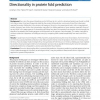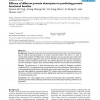188 search results - page 12 / 38 » Improving protein secondary structure prediction using a sim... |
CIBCB
2005
IEEE
14 years 1 months ago
2005
IEEE
— Part of the challenge of modeling protein sequences is their discrete nature. Many of the most powerful statistical and learning techniques are applicable to points in a Euclid...
SAC
2009
ACM
14 years 2 months ago
2009
ACM
The prediction of the correct secondary structures of large RNAs is one of the unsolved challenges of computational molecular biology. Among the major obstacles is the fact that a...
CIKM
2009
Springer
14 years 2 months ago
2009
Springer
Background: Although both conservation and correlated mutation (CM) are important information reflecting the different sorts of context in multiple sequence alignment, most of ali...
BMCBI
2010
13 years 2 months ago
2010
Background: Ever since the ground-breaking work of Anfinsen et al. in which a denatured protein was found to refold to its native state, it has been frequently stated by the prote...
BMCBI
2007
13 years 7 months ago
2007
Background: Sequence-derived structural and physicochemical descriptors have frequently been used in machine learning prediction of protein functional families, thus there is a ne...


